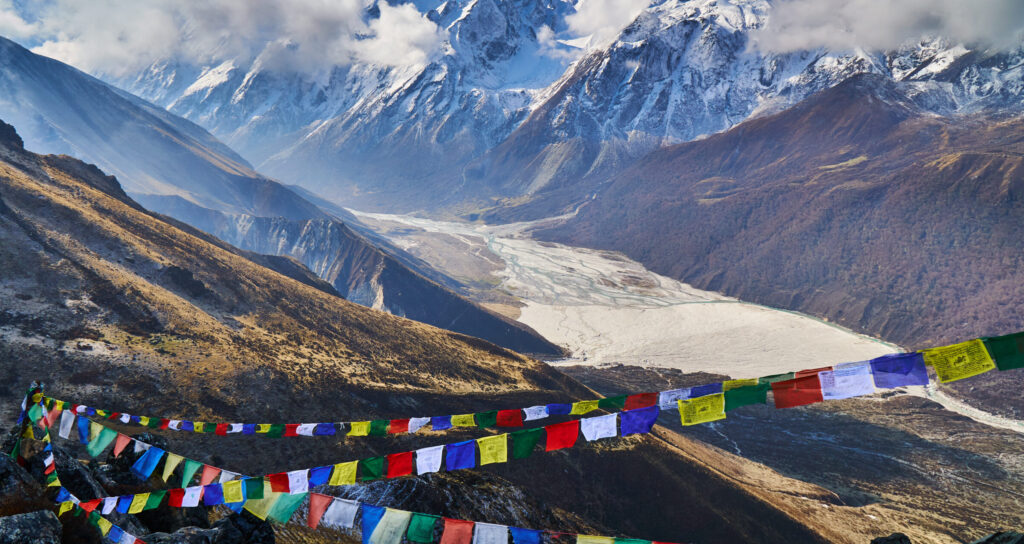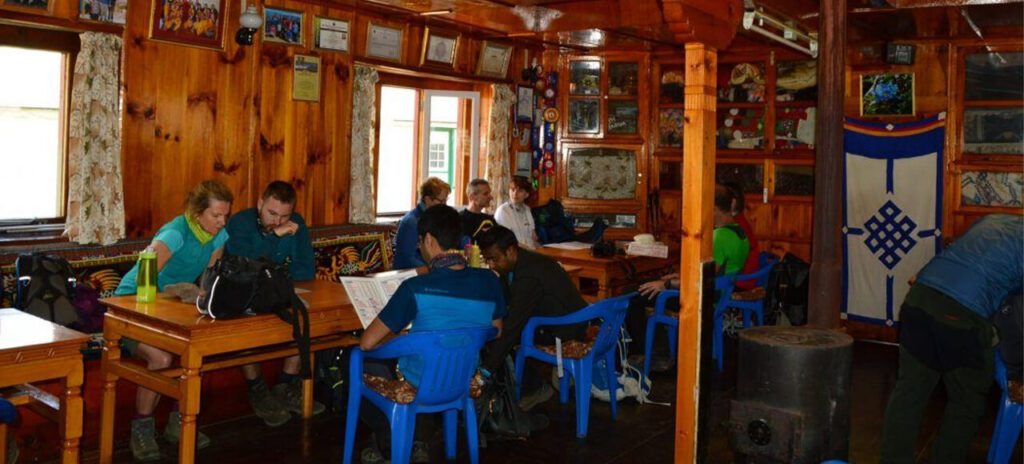Langtang Valley Trek – Imagine yourself surrounded by breathtaking Himalayan peaks looming above you. That’s what awaits you on the Langtang Valley Trek, a journey through a mystical landscape that will leave you spellbound.

As you ascend higher into the mountains, the landscape becomes more rugged and the climb more challenging. The reward is well worth it when you reach the top of Tserko Ri; you’ll enjoy breathtaking panoramic views of the surrounding peaks, including Langtang Lirung, Dorje Lakpa, and Langshisa Ri. It’s a view that will take your breath away and leave you feeling like you’re on top of the world.
The Langtang Valley trek provides a chance to immerse yourself in the distinctive culture of the local Tamang people who have resided in the Langtang region for generations. Interacting with the locals you can gain insight into their traditions and way of life while sampling local delicacies.
Itinerary
The trek usually starts from the small town of Syabrubesi and takes around 8-10 days to complete. The trek starts in the charming town of Syabrubesi where you’ll follow the Langtang River upstream passing through lush green forests of rhododendron and bamboo. Along the way, you’ll cross stunning suspension bridges that sway in the wind adding to the excitement of the adventure.

The Lama Hotel village is where you spend the night on the second day. The third day of your trip takes you to Langtang village, from which point you can see the Langtang range for the first time. The fourth day is spent adjusting to the altitude at Langtang village where you may also visit the adjacent villages and monasteries.
The fifth day takes you to Kyanjin Gompa a picturesque village that sits at the base of Langtang Lirung (7,227m). You can hike to the top of nearby hills for stunning views of the Himalayas on the sixth day.
The seventh day involves retracing your steps back to Lama Hotel while the eighth day takes you all the way back to Syabrubesi. The final day of the trek is spent driving back to Kathmandu.
Elevation of Langtang Valley trek
The Langtang Valley Trek is a popular trekking route in the Langtang region of Nepal. The highest point of this trek is Tserko Ri which is at an altitude of 4,984 meters above sea level. However, the actual height or elevation of the trek itself can vary depending on the starting and ending points as well as the specific route is taken.
Also Read: Everest Base Camp in October – Weather, Temperature, Festivals, Animals
Typically, the trek starts from the village of Syabrubesi at an altitude of around 1,503 meters and ends at Kyanjin Gompa at an altitude of around 3,870 meters with several ups and downs along the way. Overall, the Langtang Valley Trek is considered a moderate to strenuous trek due to its high altitude and challenging terrain.
Best Season for the Langtang Valley trek
The Langtang Valley trek is a popular trekking route in Nepal that takes you through the breathtaking Langtang National Park. The trek is typically 8-10 days long depending on your itinerary and fitness level and starts in the town of Syabrubesi. The Langtang Valley trek in the autumn season (October to November) is a popular choice for many trekkers because of the favorable weather conditions. The temperatures during this time are mild with daytime temperatures ranging from 10-20°C and nighttime temperatures dropping to around 0°C. The skies are usually clear and blue offering stunning views of the surrounding mountains and landscapes.

One of the highlights of the Langtang Valley trek is the beautiful landscapes that you’ll encounter. During the autumn season, the forests and fields are lush and green and the colorful foliage makes for a beautiful sight. You’ll also have the opportunity to witness the local farmers harvesting their crops providing insight into the local livelihood and farming practices. The Langtang National Park is home to a variety of wildlife including red pandas, musk deer, and Himalayan black bears. During the autumn season, the chances of spotting wildlife are higher as the weather is clear and the animals are more active. You’ll also encounter stunning glaciers, snow-capped peaks, and rugged landscapes that will take your breath away.
Langtang Valley Trek Permit
Like many other trekking routes in Nepal, Langtang Valley Trek requires trekkers to obtain several permits before embarking on the journey.
The Langtang Valley Trek permit requirements to include:
- Langtang National Park Entry Permit: All trekkers entering the Langtang National Park are required to obtain a National Park Entry Permit. The permit fee for foreigners is NPR 3,000 (approx. USD 25), while for SAARC nationals it is NPR 1,500 (approx. USD 12.5).
- TIMS CARD: All trekkers are required to obtain a Trekkers’ Information Management System (TIMS) card. The TIMS card is a record-keeping system designed to ensure the safety and security of trekkers in Nepal. The TIMS card fee is NPR 1,000 (approx. USD 8.5) for foreigners and NPR 300 (approx. USD 2.5) for SAARC nationals.
Langtang Valley Trek for Beginners
A beginner may complete the Langtang Valley Trek with the right strategy and guidance. There are no technical climbing abilities needed for the moderately demanding journey. However, it’s crucial to be at least somewhat fit and to take the appropriate measures to avoid getting altitude sickness.
The Langtang Valley trek may be an excellent opportunity for beginners to enjoy the splendor of the Himalayas and to get some trekking experience with the appropriate preparation and guidance.
Langtang Valley Trek Difficulty
The Langtang Valley trek can be considered moderately difficult to challenging due to several factors including:
Altitude
One of the main things that make the Langtang Valley walk difficult is altitude. The walk reaches a maximum height of nearly 4,500 meters and at these elevations, hikers may encounter altitude sickness. Because there is less oxygen in the air at high elevations, altitude sickness can occur. Because of this, it takes time for the body to adjust to the high altitude and lower oxygen levels. Less oxygen is present in the air at higher altitudes. Altitude sickness can include moderate headaches, nausea, exhaustion, and dizziness as well as more severe symptoms including vomiting, disorientation, and shortness of breath.
Terrain
The terrain in the Langtang Valley trek is a significant factor that adds to the overall difficulty of the trek. Trekkers will encounter steep ascents and descents, rocky paths, narrow trails, suspension bridges, and snow-covered trails depending on the season. These terrain challenges can be physically demanding and require good balance, endurance, and proper gear and equipment. The steep inclines and declines, rocky paths, and narrow trails require trekkers to have good concentration and balance while walking.
Crossing suspension bridges can be challenging, especially for those with a fear of heights and snow-covered trails can be slippery and difficult to navigate. Proper footwear and trekking poles are essential for support and stability. Trekkers need to be aware of the terrain challenges and take the necessary precautions to avoid accidents and injuries. It’s crucial to have a reasonable level of fitness and experience in hiking mountainous terrain to complete the Langtang Valley trek safely.
Duration
A significant element that increases the journey’s overall difficulty is the length of the Langtang Valley trek. The journey takes 10–12 days to complete, and hikers must be ready for the physical challenges and expectations that come with such hikes. As trekkers must walk for many hours each day, the length of the journey necessitates a respectable degree of physical condition and endurance.
Also Check: Local lifestyle at the Everest Base Camp Trek
For people who are not used to hiking for an extended amount of time, this can be physically exhausting. Additionally, altitude sickness can be a serious problem during trekking therefore hikers must take rest days to acclimate to the high altitude. Some hikers may find it difficult to acclimate to the high altitude due to the length of the climb and they may even encounter altitude sickness symptoms. Additionally, the weather in the Langtang Valley may be erratic, and depending on how long you travel you might experience various weather conditions.
Weather
Trekkers should be aware of the potential difficulties caused by weather, especially during certain times of the year. Heavy rainfall during the monsoon season can lead to landslides, rockfalls, and flash floods, making the trekking trails difficult to navigate and posing a safety risk to trekkers.

In the winter months, snow and ice can make the trails slippery and treacherous, and extreme temperatures can be a challenge, ranging from hot and humid in the summer to well below freezing in the winter. High winds can also pose a danger at higher elevations, requiring trekkers to take extra precautions.
Remote Location
The trek starts from the town of Syabrubesi, and travelers can reach it by taking a long and bumpy road journey from Kathmandu. This journey can be difficult and uncomfortable, especially during the rainy season when the roads may become slippery and treacherous. Once trekkers reach Syabrubesi, they need to prepare for the challenges of trekking in a remote and rugged environment.
The Langtang Valley is in a high-altitude region, and trekkers might encounter steep, rocky, and challenging trekking trails. The absence of modern infrastructure in the area limits accommodation and supplies, so trekkers may have to carry their own food and water for long stretches of the trek.
Another challenge posed by the remote location of the Langtang Valley Trek is the limited access to medical facilities. In case of a medical emergency, trekkers may need to be evacuated by helicopter which can be expensive and difficult to arrange in a remote area.
Tips for Langtang Valley trek
This trek is a physically demanding one, involving a lot of uphill and downhill walking so it’s important to train yourself physically before embarking on the trek. Here are some tips that can make your trekking quite a convenience:
Train Yourself
Training yourself physically before embarking on the Langtang Valley Trek is crucial to ensure that you can handle the physical demands of the trek. Therefore, it’s essential to build up your cardiovascular endurance and leg strength to be able to tackle challenging terrain. Cardio exercises like jogging, cycling, and swimming are great for building up your cardiovascular endurance. These exercises can help increase your heart rate, improve your lung capacity, and boost your overall endurance. You can start with low-intensity exercises and gradually increase the intensity and duration over time.
In addition to cardio exercises, strength training exercises like squats and lunges can also help prepare your legs for the trek. These exercises can help to improve your balance and stability and increase your overall strength. It’s recommended to incorporate strength training exercises into your training routine at least twice a week.
Get Proper Gear
Getting proper gear for the Langtang Valley Trek is essential to ensure your comfort and safety throughout the journey. The right gear can make a big difference in your overall experience especially when you are hiking in an area with varied terrain and unpredictable weather conditions. A sturdy pair of hiking boots with ankle support is something you should get.
The boots must be comfortable and strong enough for trekking on rocky and incline terrain. For stability and injury prevention during hiking, ankle support is crucial. Get a thick weatherproof jacket that can help you endure the cold and shield you from the wind and rain. During the walk, a down jacket or a synthetically insulated jacket is great for keeping you warm and cozy.
Stay Hydrated and Carry Snacks
Staying hydrated and carrying snacks is crucial while trekking in the Langtang Valley as it can be a physically demanding journey that requires a lot of energy. Dehydration and lack of food can lead to fatigue, dizziness, and other health issues which can make the trek more challenging and less enjoyable.
Carrying plenty of water is essential to stay hydrated during the trek. It’s recommended to carry at least 2-3 liters of water per day depending on your level of physical activity and the weather conditions. It’s best to use a water bottle or hydration bladder which are easy to refill at the tea houses along the trail.

Keep some energy bars or other snacks with you at all times to help you stay energized for the duration of the day. If you want a quick source of energy bring some nuts, dried fruits, or energy bars with you.
Take it Slow and Acclimize
Altitude sickness also known as acute mountain sickness is a condition that can occur when you travel to high altitudes too quickly. The symptoms can range from mild to severe and may include headache, dizziness, nausea, and shortness of breath.
The Langtang Valley Trek reaches a maximum altitude of about 4,984 meters which can cause altitude sickness in some trekkers. To prevent this it’s important to take it slow and allow your body to acclimatize to the altitude. This means that you should plan to spend a few extra days in the area to give your body time to adjust.
Hire a local guide
Hiring a local guide when embarking on a trek like the Langtang Valley Trek can be incredibly beneficial in many ways. A local guide will be familiar with the trail, the landscape, and the cultural customs of the area. They can provide you with valuable information about the trek and its surroundings, including the best routes to take, potential hazards, and interesting sights to see along the way. A local guide can also be helpful in ensuring your safety on the trek.
They will be able to assess your physical fitness and help you to adjust your pace to avoid altitude sickness. They will also have first aid knowledge in case of any injuries or emergencies. A local guide will have a deep understanding of the local culture and you will have the opportunity to learn about the customs and traditions of the area making your experience more enriching and fulfilling.







